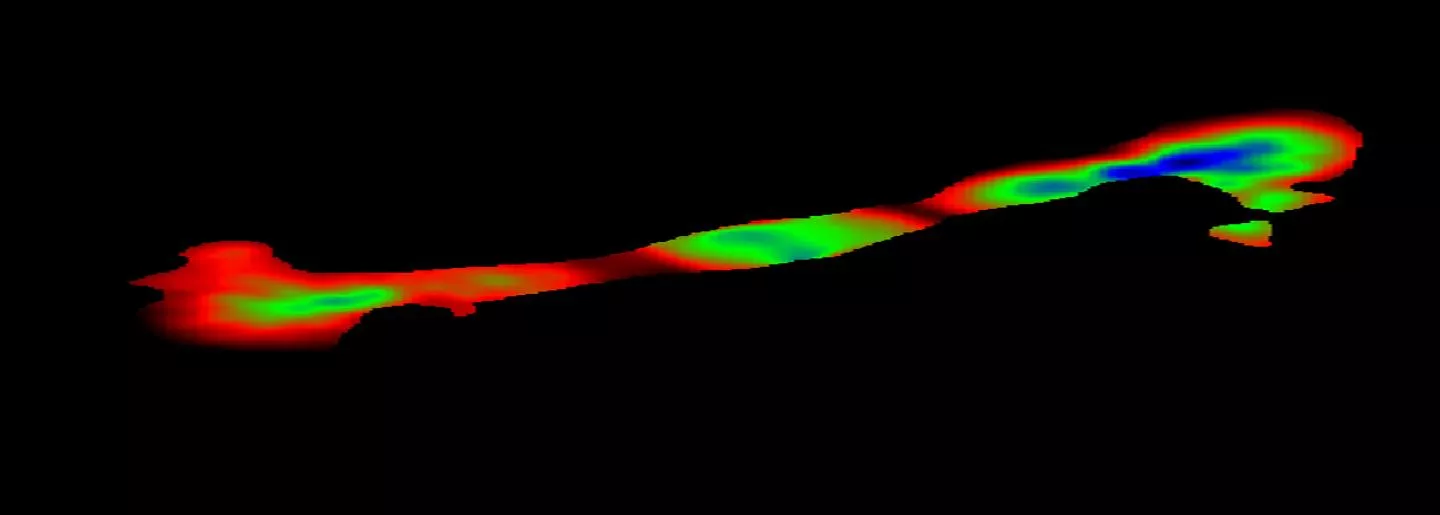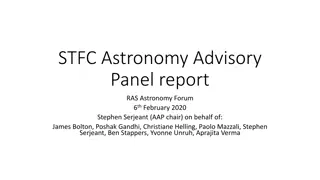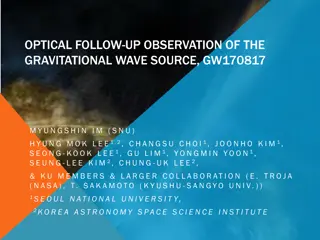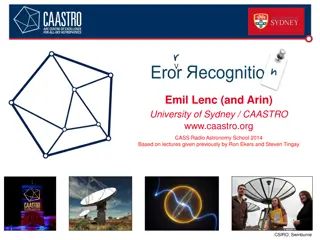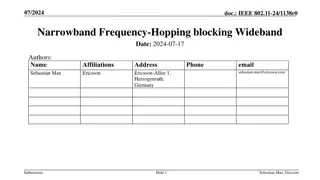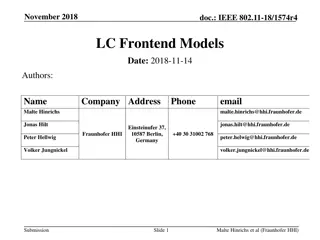Wideband Imaging and Measurements in Astronomy
Wideband imaging and measurements play a crucial role in astronomy and space science. This involves utilizing wide bandwidths to make accurate measurements and create images for continuum mapping and spectral-line observations. Increasing bandwidth enables lower thermal noise levels, quicker identification of line emissions, simultaneous observation of multiple lines, and better estimation of bandpass, leading to more precise measurements. Despite the advantages, wide bandwidths can pose challenges, necessitating strategies like dividing and conquering the bandwidth to address issues and improve imaging processes. Overall, wideband imaging techniques are essential for advancing our understanding of celestial phenomena.
Download Presentation

Please find below an Image/Link to download the presentation.
The content on the website is provided AS IS for your information and personal use only. It may not be sold, licensed, or shared on other websites without obtaining consent from the author.If you encounter any issues during the download, it is possible that the publisher has removed the file from their server.
You are allowed to download the files provided on this website for personal or commercial use, subject to the condition that they are used lawfully. All files are the property of their respective owners.
The content on the website is provided AS IS for your information and personal use only. It may not be sold, licensed, or shared on other websites without obtaining consent from the author.
E N D
Presentation Transcript
Wideband Imaging and Measurements Jamie Stevens | ATCA Senior Systems Scientist / ATCA Lead Scientist 2 October 2014 ASTRONOMY AND SPACE SCIENCE
Outline Why are wide bandwidths useful? How are wide bandwidth images made? How do we make accurate measurements from wide bands? What problems might we have with wide bandwidths? Wideband Imaging and Measurements | Jamie Stevens | Page 2
Wide Bandwidths For continuum mapping, the more bandwidth you get, the lower the thermal noise level can be. 2??? = ?? ??? 1 In this equation for RMS noise, the bandwidth enters as as the bandwidth gets larger, the noise gets smaller. ??, so Wideband Imaging and Measurements | Jamie Stevens | Page 3
Not only advantageous for continuum! Spectral-line observations can also benefit from an increase in bandwidth. Although a line is the same width regardless of the receiver bandwidth, having larger bandwidths available allows you to: more quickly search frequency-space for line emission at an unknown velocity observe more than one line simultaneously better estimate the bandpass in the emission-free bandwidth, and thus more accurately measure the line emission Wideband Imaging and Measurements | Jamie Stevens | Page 4
Divide and Conquer Wide bandwidths cause issues. Simplest solution: split up your bandwidth, and make several smaller-bandwidth images, do your measurements on each separately, or stack the images together. This is sometimes the only solution (think Ryan s frequency- changing polarisation that averages to 0), but often this approach does not let you get everything you can from your data. Wideband Imaging and Measurements | Jamie Stevens | Page 5
Imaging Wideband Continuum The imaging process for wideband continuum images is call multi- frequency synthesis. In our most popular CABB mode, the 2048 MHz of bandwidth is split into 2048 channels, each channel being 1 MHz wide. Each channel is individually gridded to make a single image covering the entire band. This can have benefits not only for sensitivity but for uv-coverage as well. Wideband Imaging and Measurements | Jamie Stevens | Page 6
uv coverage improvement 6 km array, 128 MHz bandwidth (old ATCA correlator) 6km array, 2048 MHz bandwidth (CABB correlator) Wideband Imaging and Measurements | Jamie Stevens | Page 7
Multi-frequency synthesis The observing bandwidth is split into channels, and each channel s real and imaginary components are placed on a uv grid, and the entire thing is Fourier transformed to make the image. Very easy in principle! But in reality we have a couple of complicating factors. Wideband Imaging and Measurements | Jamie Stevens | Page 8
Fractional Bandwidth The information contained in a single channel is the average of all the frequencies that channel covers. Larger channels and bandwidths make the observation more sensitive, but we also have to be aware of the fractional bandwidth that each channel represents. ?????????? ???????? = 0 where is the bandwidth (either of the channel or band), and 0 is the observing centre frequency Wideband Imaging and Measurements | Jamie Stevens | Page 9
Fractional Bandwidth For the ATCA with CABB, we have a bandwidth of 2048 MHz. In the 16cm band, which is centred at 2100 MHz, the fractional bandwidth we can observe is 1. The lowest frequency we routinely observe is 1076 MHz. Using 1 MHz channels, the fractional channel bandwidth at the lowest frequency is 0.09%. Using 64 MHz, it is 6%. Such a large fractional channel bandwidth can cause bandwidth smearing . Wideband Imaging and Measurements | Jamie Stevens | Page 10
Bandwidth Smearing The response to a point source that has coordinates ?,? on the sky will be radially elongated towards the phase centre by: ?2+ ?2 0 Consider a 6km array at 2100 MHz; it has a resolution of 2.5 arcseconds. A 64 MHz channel would smear twice that amount at ?2+ ?2 = 164 arcseconds. That s only halfway to the half-power point of the primary beam! Wideband Imaging and Measurements | Jamie Stevens | Page 11
Bandwidth Smearing 2048 x 1 MHz channels Wideband Imaging and Measurements | Jamie Stevens | Page 12
Bandwidth Smearing 32 x 64 MHz channels Wideband Imaging and Measurements | Jamie Stevens | Page 13
Bandwidth Smearing 32 x 64 MHz channels Primary Beams 3.1 GHz 2.1 GHz 1.1 GHz Wideband Imaging and Measurements | Jamie Stevens | Page 14
Bandwidth Smearing This is why we don t let observers use the 64 MHz mode for low-frequency continuum observations Wideband Imaging and Measurements | Jamie Stevens | Page 15
Spectral Index The flux density of a source is not generally the same at all frequencies. It will usually vary smoothly however, and can in most cases be described by: ? 0 ? = ?( 0) ? is the spectral index. In this lecture, our convention is that if the spectral index is negative, the flux density of the source decreases with increasing frequency. Commonly, is in GHz, and: Steep spectrum = < -0.5 Inverted spectrum = > 0.5 Flat spectrum = -0.5 < < 0.5 Wideband Imaging and Measurements | Jamie Stevens | Page 16
Calibration of Spectral Index It is very important to ensure that you account for spectral index during calibration. Ideally, the bandpass calibration can be performed with a source that has a known flux density model, such as 1934-638. This is not always possible though, since many very strong sources are quite variable. Correction of the bandpass response function can be done later if required though, as it is usually just a slope adjustment. Wideband Imaging and Measurements | Jamie Stevens | Page 17
Bandpass Correction Incorrect Bandpass Correct Bandpass Wideband Imaging and Measurements | Jamie Stevens | Page 18
Measuring Flux Density For a bright source at the phase centre, it is easy to do a linear fit for flux density as a function of frequency. log? = 0.9814 1.064log OR 1.064 ? = 9.581 1 ??? This is how all flux density measurements are made in the ATCA Calibrator Database. ? 5.5 = 1.561 Jy ? 9 = 0.924 Jy Wideband Imaging and Measurements | Jamie Stevens | Page 19
Measuring Flux Density If you need to image the field to get the flux density, you might get a different answer though. The same calibrator that we just measured via spectral fit has an image- measured flux density that is higher. This is because the spectral index hasn t been taken into account. ? 5.5 = 1.586 Jy (1.6% higher) ? 9 = 0.935 Jy (1.2% higher) Wideband Imaging and Measurements | Jamie Stevens | Page 20
Correcting Image Flux Density The band-averaged flux density of a source could be considered as the weighted mean of all the channels going in to the image. ????= ?=1 ?=1 But we know that ?? ?????( ?) ?? ???? ? ? 0 ? ? = ?( 0) So, substituting, rearranging and simplifying to equal weights: ????=?( 0) ?=1 ?? ?? ? ??? ?? ? 0 Wideband Imaging and Measurements | Jamie Stevens | Page 21
Correcting Image Flux Density We can further rearrange to recover the flux density at the reference frequency: ?( 0) =???? 0 ? ?? ?? ?? ?? ? ? ?=1 Measure the spectral indices from the images: 9.0 GHz 5.5 GHz = -1.094 = -1.068 Wideband Imaging and Measurements | Jamie Stevens | Page 22
Correcting Image Flux Density Frequency Spectral f.d. Image f.d. Corrected Image f.d. 5.5 GHz 1.561 Jy 1.586 Jy (+1.6%) 1.564 Jy (+0.2%) 9.0 GHz 0.924 Jy 0.935 Jy (+1.2%) 0.930 Jy (+0.7%) A substantial improvement in accuracy is achieved in this way. Note that this only applies to linear spectral index with no curvature, and that the correction has to be done manually (Wolfram Alpha is your friend). It is left as an exercise for the reader to deal with higher order terms: 0 0 ? ?0+ log ?1+ log ?2 Miriad cannot make images with higher order spectral index terms, but CASA can. Wideband Imaging and Measurements | Jamie Stevens | Page 23
Average Frequency Calculation Our correction equation is actually calculating the frequency that we are measuring at. ?( 0) =???? 0 ? ?? ?? ?? ?? ? ? ?=1 Obviously, ???? is actually S( ???). Now compare with: ? ? 0 ? ? = ?( 0) Identifying the correspondence and rearranging gives us the average frequency as: 1 ? ?? ?? ?=1 ???= ?? ?? ? ? Wideband Imaging and Measurements | Jamie Stevens | Page 24
Correcting Spectral Index Spectral index is dependent on the distance from the beam centre. ATCA 16cm beam 1524 MHz 2164 MHz 2932 MHz Response at the beam centre is frequency independent. Wideband Imaging and Measurements | Jamie Stevens | Page 25
Correcting Spectral Index Spectral index is dependent on the distance from the beam centre. ATCA 16cm beam 1524 MHz 2164 MHz 2932 MHz Response goes down with increasing frequency, which has the effect of steepening the spectral index. Wideband Imaging and Measurements | Jamie Stevens | Page 26
Spectral Index Correction Wideband Imaging and Measurements | Jamie Stevens | Page 27
Spectral Index Correction Not PB corrected Wideband Imaging and Measurements | Jamie Stevens | Page 28
Spectral Index Correction PB corrected Wideband Imaging and Measurements | Jamie Stevens | Page 29
Spectral Index Correction PB corrected uncorrected corrected Wideband Imaging and Measurements | Jamie Stevens | Page 30
Summary When imaging with wide bandwidths DON T average over too much fractional bandwidth DO calibrate using the spectral index of the calibrators DO Correct for beam response changes with frequency when calculating spectral index DO Use the measured spectral index to correct any measured flux densities Wideband Imaging and Measurements | Jamie Stevens | Page 31
Thank you Astronomy and Space Science Jamie Stevens ATCA Senior Systems Scientist t +61 2 6790 4064 e jamie.stevens@csiro.au w www.narrabri.atnf.csiro.au ASTRONOMY AND SPACE SCIENCE
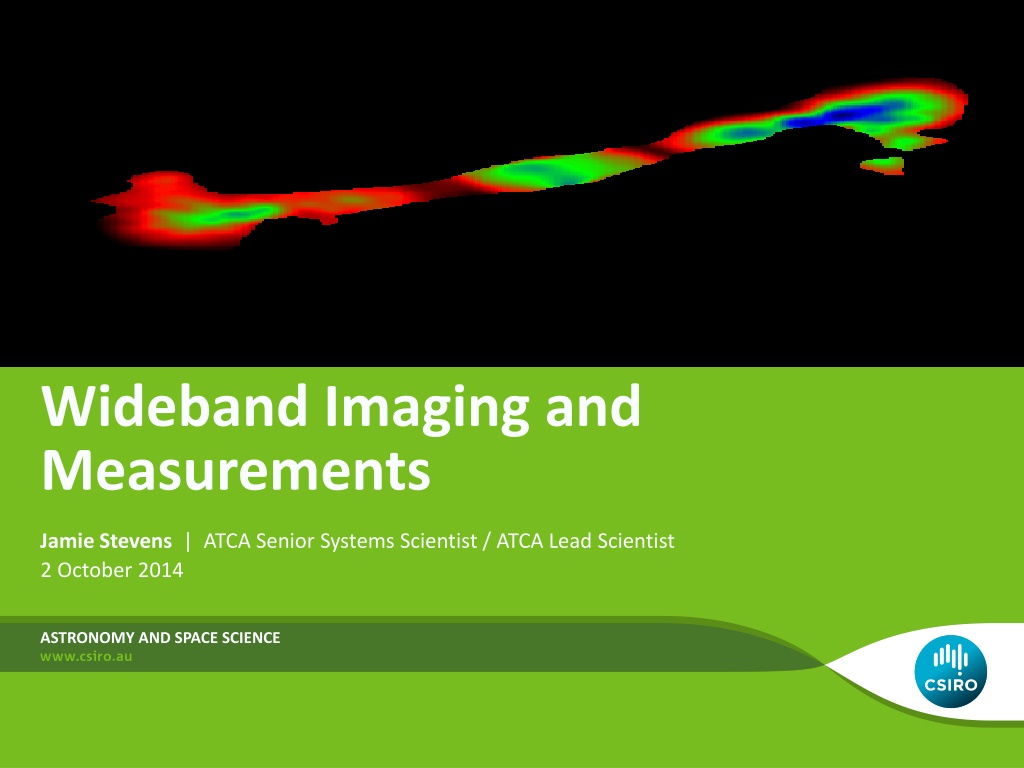
 undefined
undefined
